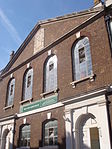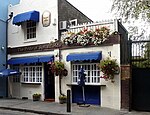Museum of Immigration and Diversity

The Museum of Immigration and Diversity is a British museum at 19 Princelet Street in Spitalfields, in the London Borough of Tower Hamlets. The Grade II listed building in which the museum is located was a house built in 1719 for the Huguenot silk merchant Peter Abraham Ogier. The house went through a number of stages, the building was converted to a synagogue in 1869. The building remained in use until the 1970s, when the congregation had moved out of the area. It has now been passed to a charity, set up to preserve the building and develop the museum of immigration and diversity. Due to the fragility of the building, the museum only opens for a few days each year. It has been given £30,000 by English Heritage for repairs and is on the Buildings at Risk Register.
Excerpt from the Wikipedia article Museum of Immigration and Diversity (License: CC BY-SA 3.0, Authors, Images).Museum of Immigration and Diversity
Princelet Street, London Whitechapel
Geographical coordinates (GPS) Address Nearby Places Show on map
Geographical coordinates (GPS)
| Latitude | Longitude |
|---|---|
| N 51.5199 ° | E -0.0725 ° |
Address
The Museum of Immigration and Diversity at 19 Princelet Street
Princelet Street
E1 6QF London, Whitechapel
England, United Kingdom
Open on Google Maps









